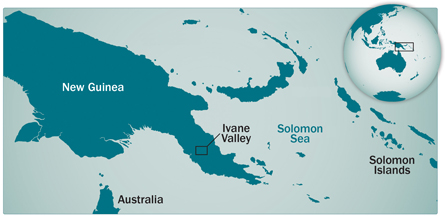Excavations in Papua New Guinea’s western highlands have turned up the oldest well-documented evidence of people in Sahul, a land mass that once joined the island to Australia.
Stone tools and plant remains indicate that, as early as 49,000 years ago, people lived 2,000 meters, or 1.2 miles, above sea level in Papua New Guinea’s Ivane Valley, say archaeologist Glenn Summerhayes of the University of Otago in Dunedin, New Zealand, and his colleagues.
By at least 50,000 years ago, modern humans occupied lowland rainforests and savannas of southeastern Asia’s land mass known as Sunda. From there they crossed the open ocean to Sahul, presumably in seacraft of some kind. Rising sea levels separated Papua New Guinea from Australia roughly 10,000 years ago.
Many researchers assume that modern humans spread from Africa to Sahul along the coast and preferred living at low altitudes. That idea gets drubbed by the new discoveries, Summerhayes says. Shortly after reaching Sahul’s shores, settlers headed uphill to the Ivane Valley’s thin air, cold temperatures and harsh habitat, the scientists conclude in the Oct. 1 Science.
“Early occupation of such adverse environments contributes to a model in which small numbers of foraging peoples moved around the Sahul landscape, colonizing new areas and then returning back to where they had been,” Summerhayes says.
Despite the challenges at high altitudes, prehistoric people had the mental savvy to survive, archaeologist Chris Gosden of the University of Oxford in England writes in a comment published in the same issue of Science. Crucial survival skills in their intellectual arsenal included an ability to remember complex travel routes and to identify potentially edible and possibly lethal plants, Gosden says.
Swift settlement of southern as well as northern Sahul occurred shortly after 50,000 years ago (SN: 3/15/03, p. 173), proposes archaeologist Matthew Spriggs of Australian National University in Canberra. “Finding the first human sites is a bit of a needle-in-the-haystack problem, but people in northern Sahul could have walked to and from what we now know as Australia,” he says.
Previous reports that people reached northern Australia at least 60,000 years ago, based on measurements of stored radiation that indicate when an artifact was buried, have drawn skepticism because of possible shifting of sediment layers and artifacts over time.
Prior research on Papua New Guinea, conducted by Summerhayes and others, has located human occupations with radiocarbon dates as old as 41,000 years along the coast and at one Ivane Valley site.
In 2007 and 2008, Summerhayes’ team found seven more ancient camps in the highland valley. Radiocarbon measures of charcoal from one site, Vilakuav, put it at between 49,000 and 43,000 years old. Other sites dated to between 41,400 and 26,000 years ago.
Each camp yielded various stone tools. Investigators found sharp implements indented in the middle, known as waisted axes, at four sites, including Vilakuav. Already known from later Stone Age sites on Papua New Guinea, waisted axes were used to clear trees and open patches of forest to sunlight so that edible and medicinal plants could grow faster, Summerhayes suggests.
Sahul settlers made stone tools where they camped, he notes. Finds included large stones from which sharp flakes had been removed and shards of rock produced during toolmaking.
Starch grains found on several stone tools came from yams, a food that must have been gathered in its natural range at lower altitudes, the researchers say.
Charred nut shells from high-altitude Pandanus trees turned up at Vilakuav and at three other sites. Ancient settlers ate these nuts and probably a pineapple-like fruit that grows on Pandanus trees, the scientists suspect.
Excavations at Vilakuav also produced burned bone fragments from unidentified animals that had been hunted, in Summerhayes’ view. Available game probably included animals still found in the region — possums, tree kangaroos, bats, frogs, anteaters, lizards, snakes and birds.
Farming began in Papua New Guinea’s highlands about 9,000 years ago. Today, Gosden points out, farming populations thrive where small bands of foragers once scrounged out a living.








